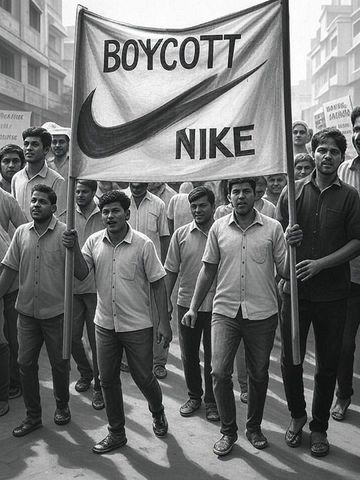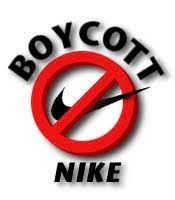#BoycottNike: How a Misstep Sparked Outrage in India
The Spark: A Misstep in Nike’s Indian Campaign
Nike’s collaboration with NorBlack NorWhite, launched globally on June 11, 2025, was a bold step to deepen its footprint in India, a market where it has historically trailed competitors like Adidas and Reebok. The collection, designed to “invite women into sport” while celebrating Indian craftsmanship, featured sportswear infused with bandhani patterns and showcased Indian athletes like wrestler Anshu Malik, sprinter Priya Mohan, and cricketers Jemimah Rodrigues and Shafali Verma. Shot in Jaipur, the campaign was meant to resonate with Indian consumers by blending local heritage with modern streetwear aesthetics.
However, the campaign took a controversial turn when an Instagram post by @CuratedCultureSociety misidentified a model in the campaign as a US-based Bangladeshi influencer named Naley (@naleybynature). The post alleged that Naley had previously made statements referring to Jammu & Kashmir as “occupied by India” and questioned India’s claims regarding a recent terror attack in Pahalgam. These claims, perceived as undermining India’s sovereignty, ignited widespread outrage among Indian social media users. Comments like “What’s a Bangladeshi doing in an Indian ad? That too a paid propaganda lady who spreads hatred against India!” and calls to “#BoycottNike” began flooding platforms, amplified by political commentator Rishi Bagree and other influential voices.

Misinformation and Clarifications
As the #BoycottNike hashtag gained traction, fact-checking efforts revealed that the controversy stemmed from a case of mistaken identity. I can confirm that Nike’s 2025 India campaign exclusively featured NorBlack NorWhite, an Indian label founded by Canadian-born designers Mriga Kapadiya and Amrit Kumar, and included only Indian models and athletes. The claim about Naley’s involvement appears to have confused Nike’s current campaign with an unrelated 2023 collaboration involving a British-Bangladeshi designer, Saeedah Haque, which had no connection to the Indian market.
Despite these clarifications, the initial outrage had already taken root. The @CuratedCultureSociety account deleted its original post, issuing an apology: “We’re truly sorry if our recent post caused hurt or offence. We were not aware that the individual featured in the first slide had previously made any statements related to recent events in India.” However, the apology did little to quell the anger, as many users felt Nike’s silence on the issue signaled complicity or indifference. Posts on X, such as one by @wisdom_walkss stating, “Nike choosing someone who has openly mocked India and denied the sovereignty of Jammu & Kashmir… is a direct insult to national integrity,” further fueled the narrative.
Nike’s Silence and the Amplification of Outrage
As of June 18, 2025, Nike has not issued an official statement addressing the controversy, a decision that has intensified public anger. In a market as sentiment-driven as India, where national pride and territorial integrity are deeply emotive issues, the brand’s silence has been perceived as a lack of cultural sensitivity. Social media users have drawn parallels to other global brands’ missteps, with one X post noting, “If #Adidas can drop Kanye West for antisemitism, Nike can do the same. We need a collective voice like the Jewish community. #BoycottNikeIndia.”
The controversy has also been contextualized within India’s broader socio-political climate. Recent tensions with neighboring countries, including Turkey’s support for Pakistan in India-Pakistan conflicts, have heightened nationalist sentiments. Calls for boycotts, such as the #BoycottTurkey movement in May 2025, reflect a growing trend of Indian consumers leveraging their purchasing power to express disapproval of perceived slights against national interests. The #BoycottNike movement fits into this pattern, with users like @miglani3 speculating that Nike may have deliberately courted controversy to exit the Indian market without fulfilling financial obligations to investors—a claim that remains unsubstantiated but highlights the depth of distrust.
The Broader Context: Global Brands in India
Nike’s challenges in India are not new. With only 93 stores in the country compared to over 2,600 in China, the brand has struggled to compete with local and international rivals. Its 2005 deal to outfit the Indian cricket team was a high-profile win, but the women’s apparel segment, which the Nor Black Nor White collection targets, has lagged behind. The #BoycottNike controversy underscores the delicate balance global brands must strike when entering culturally and politically sensitive markets like India.
The backlash also highlights the power of social media in shaping consumer sentiment. Platforms like X have become battlegrounds for public opinion, where misinformation can spread rapidly, and brands can face significant reputational damage within hours. The role of influencers, both in sparking and mitigating controversies, cannot be overstated. In this case, the misidentification of a model amplified by influential accounts demonstrates how quickly narratives can spiral out of control.
Implications and Lessons
The #BoycottNike movement raises critical questions about how global brands can navigate cultural sensitivities in diverse markets. For Nike, the controversy could have long-term implications, including loss of consumer trust and market share in India. Competitors like Adidas and local brands may capitalize on the sentiment, positioning themselves as more attuned to Indian values. The incident also underscores the importance of proactive communication. Had Nike swiftly addressed the misinformation and reaffirmed its commitment to Indian culture, it might have mitigated the backlash.
For other brands, the lesson is clear: thorough vetting of campaign elements, including models, influencers, and messaging, is essential in politically charged environments. Moreover, brands must be prepared to respond quickly and transparently to controversies, particularly in markets where national pride is a significant consumer driver. Engaging local expertise and fostering genuine connections with the target audience can help avoid missteps that alienate consumers.
Conclusion
The #BoycottNike movement in India is a case study in the complexities of global branding in a hyper-connected, politically sensitive world. What began as a celebration of Indian craftsmanship through Nike’s collaboration with Nor Black Nor White morphed into a public relations crisis due to misinformation and heightened nationalist sentiments. As the hashtag continues to trend, Nike’s response—or lack thereof—will determine whether it can regain the trust of Indian consumers. In an era where social media amplifies voices and shapes perceptions, brands must tread carefully, balancing creativity with cultural respect to thrive in diverse markets.
Last Updated on: Wednesday, June 18, 2025 5:26 pm by Sri Hari Priya Rayaprolu | Published by: Sri Hari Priya Rayaprolu on Wednesday, June 18, 2025 5:25 pm | News Categories: Trending, Brand Post, Business, India







